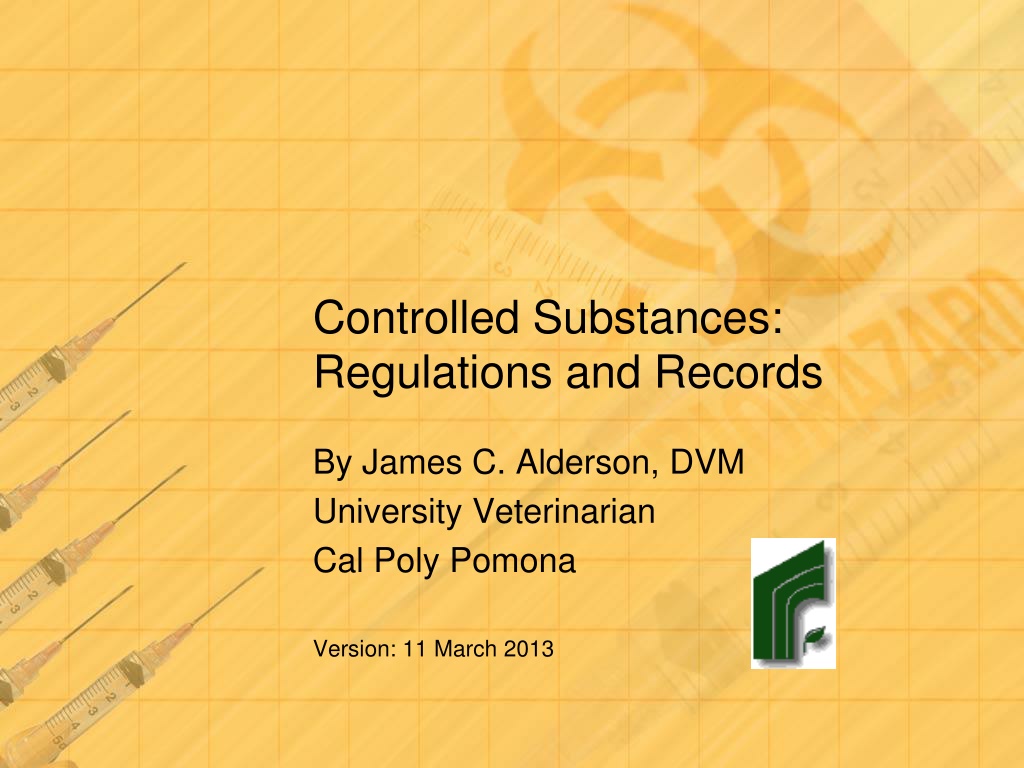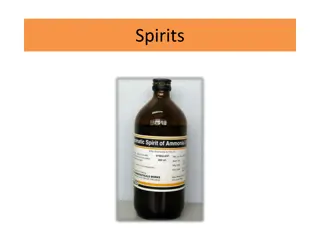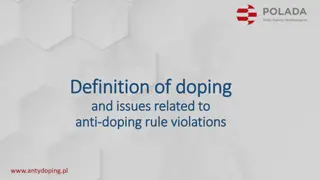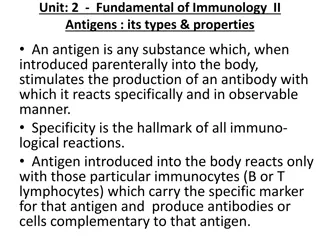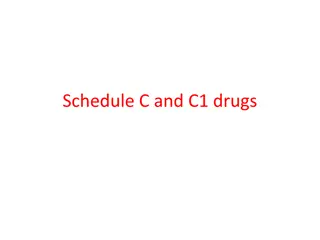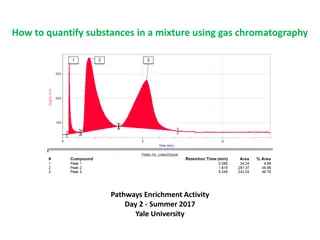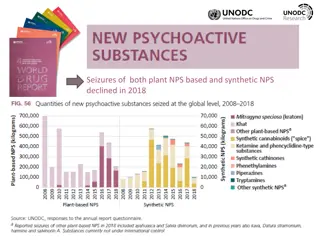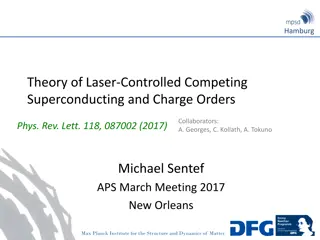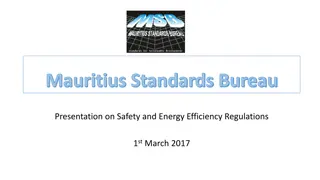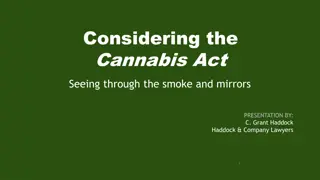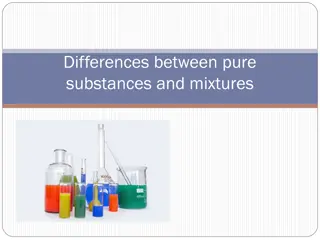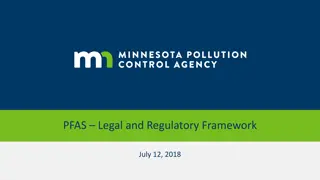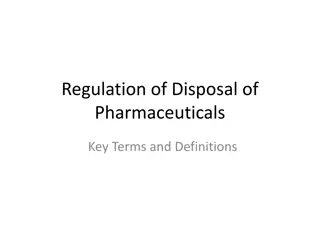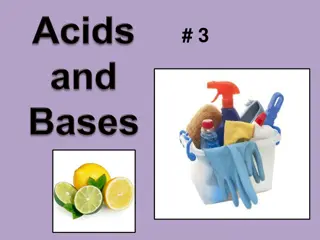Understanding Controlled Substances Regulations: A Comprehensive Overview
Controlled substances are drugs regulated by federal and state laws to manage addiction, abuse, and potential harm. The DEA enforces these laws with strict penalties for violations based on different drug schedules ranging from I to V.
Download Presentation

Please find below an Image/Link to download the presentation.
The content on the website is provided AS IS for your information and personal use only. It may not be sold, licensed, or shared on other websites without obtaining consent from the author. Download presentation by click this link. If you encounter any issues during the download, it is possible that the publisher has removed the file from their server.
E N D
Presentation Transcript
Controlled Substances: Regulations and Records By James C. Alderson, DVM University Veterinarian Cal Poly Pomona Version: 11 March 2013
What are Controlled Substances? Controlled substances are drugs which are regulated by federal and state law. The production, possession, importation, and distribution of these drugs is strictly regulated or outlawed, although many may be dispensed by prescription only. The basis for the regulation is to control the danger of addiction, abuse, physical and mental harm, the trafficking by illegal means, and the dangers from actions of those who have used these substances.
What agency is responsible for Controlled Substances? Controlled substance laws are enforced by the Department of Justice, Drug Enforcement Agency (DEA) Violations of controlled substance laws carry heavy penalties. DEA agents frequently carry weapons, even for routine inspections.
Penalties for Controlled Substance Violations DRUG/ SCHEDULE Other Schedule I & II Drugs (& any product containing Gamma Hydroxybutyric Acid) QUANTITY PENALTIES Any amount First Offense: Not more than 20 yrs. If death or serious injury, not less than 20 yrs, or more than life. Fine $1 million if an individual, $5 million if not an individual. Second Offense: Not more than 30 yrs. If death or serious injury, not less than life. Fine $2 million if an individual, $10 million if not an individual. Flunitrazepam (Schedule IV) 1 gm or more Other Schedule III drugs Any amount First Offense: Not more than 5 yrs. Fine not more than $250, 000 if an individual, $1 million if not an individual. Second Offense: Not more than 10 yrs. Fine not more than $500,000 if an individual, $2 million if not an individual. Flunitrazepam (Schedule IV) 30 999 mgs All other Schedule IV drugs Any amount First Offense: Not more than 3 yrs. Fine not more than $250,000 if an individual, $1 million if not an individual. Second Offense: Not more than 6 yrs. Fine not more than $500,000 if an individual, $2 million if not an individual. Flunitrazepam (Rohypnol) (Schedule IV) Less than 30 mgs All schedule V drugs Any amount First Offense: Not more than 1 yr. Fine not more than $100,000 if an individual, $250,000 if not an individual. Second Offense: Not more than 2 yrs. Fine not more than $200,000 if an individual, $500,000 if not an individual.
Controlled Substance Schedules The substances are listed in five categories, or schedules, according to their characteristics, such as dangerousness, medical usage and addictive properties. The Schedules are denoted as I V, with Schedule I being the most dangerous and the highest potential for abuse and Schedule V being the least dangerous and lowest potential for abuse.
Controlled Substances DEA Schedules Controlled Substances are segregated into DEA Schedules I, II, III, IV, or V based upon: Abuse potential, Medical value, and the Danger of serious physical effects to the user.
What substances are controlled? The complete list of controlled substances and their schedules are on the DEA website. The website contains very specific details as to how the drugs are classified. http://www.deadiversion.usdoj.gov/21 cfr/21usc/812.htm You do not have to look them up on the list. All controlled substances are clearly marked. Controlled substances are labeled with a large C with their schedule within the C .
#1 DEA Schedules Schedule I A high potential for abuse. Have no currently accepted medical use in treatment in the U.S. Lack of accepted safety for use of the drug or other substance under medical supervision. Some examples of substances listed in schedule I are: heroin, lysergic acid diethylamide (LSD) marijuana (cannabis) peyote, methaqualone 3,4 methylenedioxymethamphetamine ( ecstasy )
#2 DEA Schedules Schedule II The drug or other substance has a high potential for abuse. The drug or other substance has a currently accepted medical use in treatment in the United States or a currently accepted medical use with severe restrictions. Abuse of the drug or other substances may lead to severe psychological or physical dependence. Examples of Schedule II Drugs: cocaine, amphetamines, pentobarbital, etorphine, fentanyl, codeine, and many other opioids.
#3 DEA Schedules Schedule III The drug or other substance has a potential for abuse less than the drugs or other substances in schedules I and II. The drug or other substance has a currently accepted medical use in treatment in the United States. Abuse of the drug or other substance may lead to moderate or low physical dependence or high psychological dependence. Examples of Schedule III Drugs: barbiturates, hydrocodone, ketamine
#4 DEA Schedules Schedule IV The drug or other substance has a low potential for abuse relative to the drugs or other substances in schedule III. The drug or other substance has a currently accepted medical use in treatment in the United States. Abuse of the drug or other substance may lead to limited physical dependence or psychological dependence relative to the drugs or other substances in schedule III. Examples of Schedule IV drugs: diazepam, phenobarbital, butorphanol, phenobarbital
#5 DEA Schedules Schedule V The drug or other substance has a low potential for abuse relative to the drugs or other substances in schedule IV. The drug or other substance has a currently accepted medical use in treatment in the United States. Abuse of the drug or other substance may lead to limited physical dependence or psychological dependence relative to the drugs or other substances in schedule IV. Examples of Schedule V drugs: buprenorphine, diphenoxylate, codeine cough syrup
Getting a DEA License To obtain a DEA registration, a practitioner must apply using a DEA Form 224. Applicants may submit the form by hard copy or online. www.DEAdiversion.usdoj.gov (DEA Diversion Internet Web Site) DEA Headquarters Registration Section in Washington, D.C. at 1-800- 882-9539 (Registration Call Center)
Applying for a DEA License The DEA Form-224 may be completed online or in hard copy and mailed to: Drug Enforcement Administration Registration Unit Central Station P.O. Box 28083 Washington, D.C. 20038-8083 Veterinarians, doctors, dentist and pharmacists can register. Persons doing research can register for specific drugs. The fee is expensive, but it is waived for those working at state or federal institutions
Purchase of Controlled Substances The vendor must have a copy of your DEA license in order for you to order Controlled Substances. Registration categories of interest Practitioner Researcher (Principal Investigator) Reverse Distributor
Ordering of Controlled Substances The vendor must have a current copy of your DEA license on file. The drug can only be shipped to the address on your license. Shipment tracking must be used. Once you take possession of the substance, you are responsible for its handling. Schedules I & II require an order form
Storage of Controlled Substances Must be stored in a double locked, secured container. The storage box must be bolted or otherwise secured to an immovable object. The holder of the license should have possession of the keys to the storage box. Do not label the cabinet on the outside (making it easier for would be thieves to locate the dugs).
Controlled Substances Logs A log book must be maintained for each drug. Each log book contains: Authorized Users Signature Log Unopened container log Opened container log One Biennial Inventory log book must be maintained for all drugs Ideally, the drug logs should be kept in the drug cabinet. If this is not possible, they should be kept in a secure location near the controlled substances cabinet. web_CNSB2.jpg (400 400) (Click the picture to purchase the complete set for 6 drugs - $12.95)
The Authorized Users Signature log The signatures and initials of the DEA license holder and all authorized personnel under the direct supervision of the license holder record their information in this section at the beginning of the log book.
THE UNOPENED CONTAINER LOG Schedule I and II drug logs should be maintained separately from Schedule III, IV, and V drug logs. Each drug should have its own unopened container log. DRUG NAME: Enter the name of the drug. CONTAINER SIZE: Enter the number of pills or mls of liquid in each container. STRENGTH: Enter the strength of the drug. FORM: Enter the form of the drug (e.g., tablet, injectable, patch, liquid, etc.). DATE: Enter the date the activity took place. STARTING BALANCE (FROM PREVIOUS PAGE): Enter the balance from the previous page used in your logbook.
THE UNOPENED CONTAINER LOG EXPLANATION OF ACTIVITY: Enter what movement has taken place with the drug, for example receiving bottles into stock or moving one into the opened container log. LOT#: Enter the lot number of the bottle(s) being received into stock. If there is more than one lot number, make more than one entry in the log to account for each lot. UNIQUE BTL.#: Each bottle is assigned a unique number moving from the Unopened Container Log to the Opened Container Log. The bottles should be moved to the opened container log in numerical order.
THE UNOPENED CONTAINER LOG The next order should also be numbered sequentially, but starting with where you left off when numbering the previous order of the same drug. EXP. DATE: Enter the expiration date of the drug. AMOUNT ADDED/OPENED: In the appropriate column, enter the amount of the drug that has moved. Make entry in units (e.g., ml). BALANCE: Enter the new balance of this drug on the Unopened Container Log after the shipment has been checked in or a movement has taken place. Make entry in units (e.g., ml).
THE UNOPENED CONTAINER LOG INITIALS: The authorized staff member who handled the drug movement enters his or her initials. INITIALS WHEN PHYSICAL COUNT TAKEN: Enter the initials of the inventory taker. Only initials approved in the Initials Entry Log are allowed. Physical counts should be done periodically and it should be recorded that the physical count matches the Unopened Container Log amount. If a discrepancy exists between the log book and the physical count, it must be explained.
THE OPENED CONTAINER LOG OPENED CONTAINER LOG ACCOUNTS for bottles that are in use. When a bottle is opened, it is deducted from the Unopened Container Log, and an entry is made in the Opened Container Log. Remember to empty the previous bottle in use before opening a new bottle. A separate opened container log book must be maintained for each controlled substance. Make sure date and the amount of substances transferred from the unopened container log to the opened container log are recorded in both log books.
THE OPENED CONTAINER LOG DRUG NAME: Enter the name of the drug. CONTAINER SIZE: Enter the size of the container in which the drug is ordered and received. STRENGTH: Enter the strength of the drug. FORM: Enter the form of the drug (e.g., tablet, injectable, patch, liquid, etc.). DATE: Enter the date the activity took place. STARTING BALANCE (FROM PREVIOUS PAGE): Enter the balance from the previous page used in your logbook. Moving the current balance to the current log page allows for easier addition/subtraction and also makes it easier to track mathematical processes from one page to the next.
THE OPENED CONTAINER LOG CLIENT, PATIENT: Enter the client name and patient name. In the case of research, name the species and the protocol number. When bottles are being transferred from the Unopened Container Log in the Opened Container Log, the lot number description can also be entered here. UNIQUE BTL. #: For example, when 10 bottles of diazepam injectable are received, the bottles each receive a number from 1 to 10; they are then tracked so they are used in order, moving from the Unopened Container Log to the Opened Container. The bottles should be moved from the Unopened Container Log to the Opened Container Log in sequential order.
THE OPENED CONTAINER LOG REASON/NOTES: Enter the reason why the drug was used or moved, for example patient use for a specific treatment or a new bottle needed. AMOUNT ADDED/USED: In the appropriate column, enter the amount of the drug that has been used/moved. Be sure to include units (e.g., ml). BALANCE: Enter the new balance in the opened container on the Opened Container Log. Be sure to include units (e.g., ml). INITIALS: The authorized staff member enters his or her initials. INITIALS WHEN PHYSICAL COUNT TAKEN: Enter the initials of the inventory taker. Only initials approved in the Initials Entry Log are allowed.
BIENNIAL CONTROLLED SUBSTANCES INVENTORY LOG
BIENNIAL CONTROLLED SUBSTANCES INVENTORY LOG The Opened and unopened logs are required to be kept for 2 years. New log books can be started using the Biennial Inventory logs. By law, you only need to update these every 2 years, but most update these annually or every six months.
REVERSE DISTRIBUTORS All expired or unused controlled substances must be turned over to a Reverse Distributor licensed by the DEA. If you have expired controlled substances, mark them accordingly and store them in the controlled substances cabinet until they can be relinquished to the reverse distributor. You will get a receipt for your controlled substances. Record this in your drug logs (opened or unopened container). Keep the receipt in a notebook with your order packing slips/invoices.
WRAPPING UP WITH SOME IMPORTANT POINTS Many of these drugs have a high street value and the danger of theft and misuse is high. Know your students, employees!!! The license holder is ultimately responsible for the controlled substance purchased with his/her license. As the license holder you will be held completely responsible for their disposition. The DEA does random unannounced inspections. Always keep your drug cabinet locked, the keys in the possession of the license holder and the log books up to date!! Keys should be kept ???
WRAPPING UP WITH SOME IMPORTANT POINTS If a controlled substance container breaks, enter it on the log sheet, initialed by the individual responsible for the accident and co-signed by the PI (license holder). Computerized versions of log books are not acceptable to the DEA. Maintain a notebook containing all packing slips, with delivery information for your controlled substances. Dates of delivery, delivery amounts and any drug shortages should be noted on the packing slip. The slip should be initialed and dated by an individual whose signature is recorded in the Authorized Signature Log. The DEA may ask to see the records of your shipments. You are required to keep them for two years. Receipts from the reverse distributor should also be kept in this notebook. Ideally this notebook should be stored in the drug cabinet with the drug logs.
OTHER POINTS Contacts, should you have other questions: Riskmanagment ACUC EH&S
